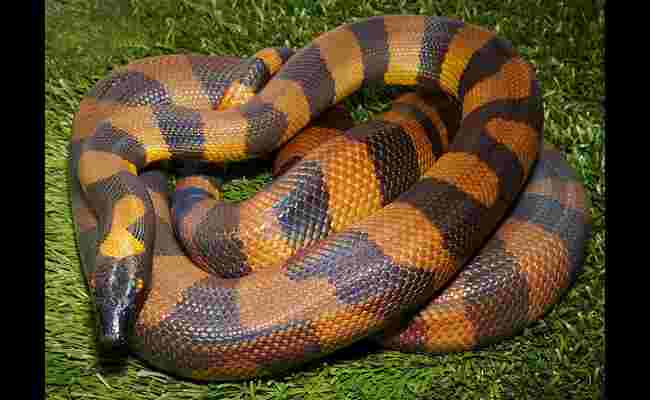Bismarck Ringed Python 2023 Best Info is our today’s topic. The Bismarck-ringed python is a remarkable snake in the Bismarck Archipelago. It’s known for its vibrant colors and unique behaviors. Let’s explore some interesting facts about this amazing snake!
Bismarck Ringed Python 2023 Best Info

| Bismarck Ringed Python Scientific Classification | Bismarck Ringed Python Conservation Status | |
Kingdom | Animalia | Least Concern |
Phylum | Chordata | |
Class | Reptilia | |
Order | Squamata | |
Family | Pythonidae | |
Genus | Bothrochilus | |
Scientific Name | Bothrochilus boa | |
Bismarck Ringed Python Facts | Bismarck Ringed Python Physical Characteristics | ||
| Prey | Small mammals, lizards, and possibly other snakes | Color | Brown, Red, Black, Orange |
| Main Prey | Rodents | Skin Type | Scales |
| Name Of Young | Hatchling, snakelet | Top Speed | One mph |
| Group Behavior | Solitary, Solitary except during mating season | Lifespan | 20+ years |
| Fun Fact | When these snakes are babies, they look like Halloween snakes with their bright orange and black bands. | Length | 4-6 feet long |
| Estimated Population Size | Unknown | Venomous | No |
| Biggest Threat | Over collection for the pet trade. | Aggression | Low |
| Most Distinctive Feature | Black and orange to orange-brown rings | ||
| Other Name(s) | Ringed python | ||
| Age Of Independence | When they hatch | ||
| Diet for this Fish | Omnivore | ||
| Lifestyle | Nocturnal, Crepuscular | ||
| Favorite Food | Small mammals | ||
| Common Name | Ringed python | ||
| Special Features | Glossy black head | ||
| Number Of Species | 1 | ||
| Location | Bismarck Archipelago | ||
| Average Clutch Size | 9 | ||
Colorful Transformation:
When Bismarck’s ringed pythons hatch, they are bright orange and black. As they grow over their first year or two, their colors change to orange-brown, yellow, and black.
Also Read:
Heat-sensing Pits:
Unlike most python species, Bismarck ringed pythons have fewer heat-sensing pits, which are located on their lower rear lip. These pits help them detect warm-blooded prey.
Egg Care:
Female Bismarck-ringed pythons may or may not incubate their eggs. They are not as attentive to their eggs as other python species, which is unique.
Scientific Name And Classification:
The scientific name of this snake is Bothrochilus boa. It’s the only species in the Bothrochilus genus. The term “Bothrochilus” combines “Bothros,” meaning pit or hole, and “chilus,” which means -like.
Appearance:
Adult Bismarck-ringed pythons grow to be about 5-6 feet long. Their color pattern changes from bright orange with black rings as juveniles to orange-brown and black with iridescent scales as adults. Their heads are small and glossy black with dark eyes.
Behavior:
These pythons are active snakes, often foraging actively for their prey. They are not lethargic like other pythons and have a high metabolism, requiring frequent feedings. They are not aggressive but can be challenging to handle due to their constant movement.
History And Evolution:
Pythons evolved from reptiles with legs, which eventually became vestigial or disappeared. This adaptation allowed them to become ground-dwelling and better suited for hunting and avoiding predators.
Habitat And Diet:
Bismarck ringed pythons are found in the Bismarck Archipelago’s rainforests, coconut plantations, and river banks. They primarily feed on small mammals, lizards, and sometimes other snakes.
Predators, Threats, And Conservation:
Their main threats include the pet trade and habitat destruction. Indigenous people in New Guinea also hunt them for food. While they are not well-studied in the wild, birds of prey and larger carnivores likely prey on them.
Reproduction And Lifespan:
These pythons mature at 4-6 years of age and lay up to a dozen eggs. Some females protect their eggs, while others do not. After about 65 days, the baby pythons hatch and can live for over 20 years.
Similar Animals:
Some similar python species include the Reticulated Python, Black-Headed Python, and Amethystine (Scrub) Python.
Bismarck Ringed Python FAQs:
Where Do Bismarck Ringed Pythons Live?
These snakes are native to the Bismarck Archipelago, off the coast of New Guinea.
How Do Bismarck Ringed Pythons Hunt?
They are active foragers, constantly looking for prey, and most active during the evening and night.
What Do Bismarck Ringed Pythons Eat?
Their primary diet consists of small mammals, but they may also eat other snakes.
Are Bismarck Ringed Pythons Aggressive?
They are not aggressive but may bite or musk if approached too quickly. They are timid and need time to adjust.
Do Bismarck Ringed Pythons Make Good Pets?
While they can be kept as pets, they require more care and attention than other snake species. Their humidity needs to be monitored, and they may take time to adjust to captivity.
I hope you enjoy reading our article Bismarck Ringed Python 2023 Best Info.


